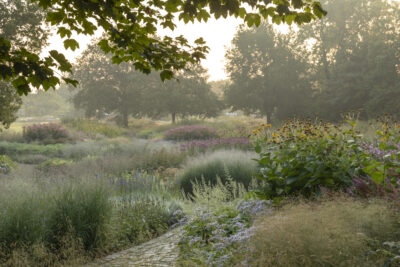The second part of my april series is about woods at Hermannshof. There are many specias trees and shrubs. From early april on the magnolia are in bloom, especially the beautiful soulangea „Lennei Alba“ in the middle of the great lawn. Grand and gorgeous it reins the scenery. It was planted in 1888. At the same time the huge magnolia denudata was planted in front of the villa.

End of february, the Eranthis, Galanthus and Crocus tommasianus are still in bloom at the feet of the magnolia.

The cherrys are in bloom too, and rare shrubs like Stachyrus praecox show their special stucture. On the back side of the dry hill sits a Chaenomeles, which I really love because the colour of the flower is so special. Usually, I don’t like them because of their thorny, straight branches. But with this soft powdery yellow, even Chaenomeles makes sense.

Gehölze Ende April Woods end of april
At this time, the show winner is Cercis siliquastrum. It blooms in an unbelievable voilet-pinkish colour with thick tussocks of flowers on the branches. It dominates the air above the flood of tulips.
Another eyecatcher is the Davidia. This crazy year has brought a mild and dry winter, then days of frost in april. Many sensible plants were damaged. At risk were the huge white flowers of the Davidia, they are as big as handkerchiefs. In many gardens the tree had black flowers because of the frost. At Hermannshof, they were lucky. Prof. Cassian Schmidt told us that the layer of cold air was only 3 ft in heigth and flew down the hill fast. So the Davidia was still in wonderful innocent white.
For the beautiful Wisteria, which you can see on den upper right I will write another blogpost.
Did you see that the last two pictures were made with a special lens? I looked for a long time for a wide angle lens with more than 24mm which is very fast and does not cost some thousand Euros. Finally I found one and decided to buy a 15mm with fixed focal length, the Blackstone 2,5 from Irix. Until now the quality is great, the pictures are sharp and fresh. I’m still experimenting how to make good pictures because with full-format camera and 15mm there are some distortions which is normal. Simply I have to learn how to take good pictures with this lens.
But back to Hermannshof as we are talking about woods here. Next to the Davidia, there is a huge Malus hupehensis with three stems, planted in 1924. From the upper side of the lawn it is the center point of a fantastic scenery at this time of the year. You can see here Wisteria, Cercis, Davidia and the lilac blooming Syringa x chinensis. In the foreground are the upcoming Camassia, Euphorbia palustris, Narcissus poeticus and a carpet of Omphalodes, which grow in the wet meadow.
In the paeony garden
But this is not all you can see: Left from the main entrance is the tree paeony garden. Tree paeonies build woody stems and can grow as high as 6-9 ft. The biggest ones are the Paeonia lutea at the east asian woods at the other end of the garden. All tree paeonies have fantastic flowers, even the simple flowers are awesome. The blooming time is very short but spectacular. End of april there were mostly buds to see and the brownish colour of the new leaves. I love not only the flowers but also the leaves and their structure in the garden.
Until the spectacular bloom the eyecatchers in this part of the garden are the yellow and lilac tulips and a huge rose. It is as big as 6 x 9 ft and their hanging branches are covered with yellow flowers. That’s why it’s called „Canary Bird“. I saw it and wanted to have it – but it only grows in a climate as mild as in Weinheim.
The center of this so perfectly combined part of the garden are a small Cercis and a white Wisteria japonica. The Wisteria is trimmed as a small tree and the panicles grow to 3 ft in length. At this moment, the view changes from yellow to lilac, but you still get the impression what the garden will be in some weeks during the paeony bloom: a symphony of lilac, pink and white.
Ein kleiner Cercis und eine weiße Wisteria japonica bilden einen Mittelpunkt in diesem mit so sicherer Hand gelungen komponierten Gartenbereich. Die Wisteria ist wie ein Kleinbaum geschnitten, die Rispen werden sehr lang, bis zu einem Meter. So wechselt der Blick jetzt zwischen violett und gelb, gibt aber eine Ahnung davon, dass in der bald kommenden Päonienblüte Violett – Rosa- und Weiß-Töne dominieren.







Schreibe einen Kommentar